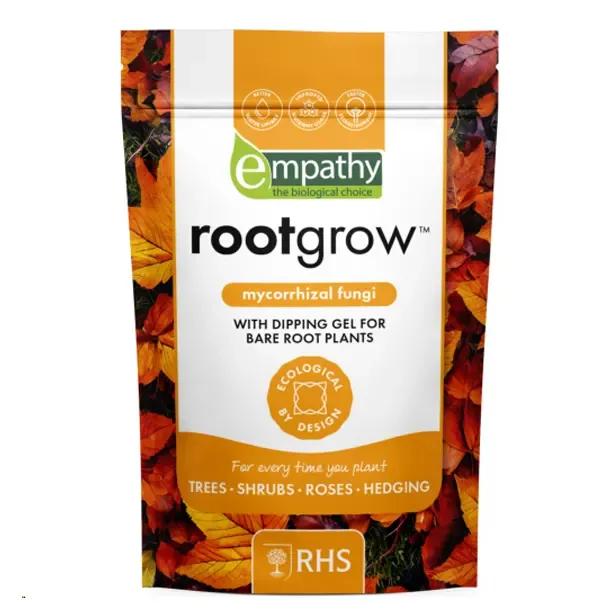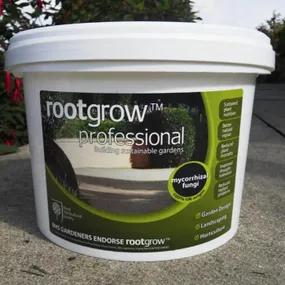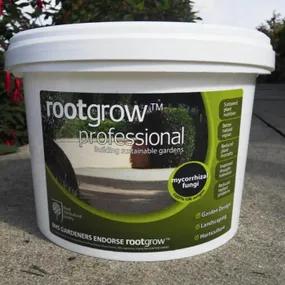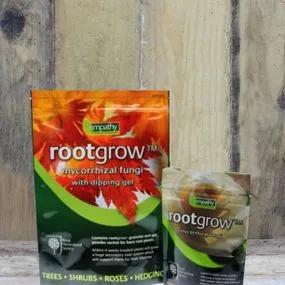Rootgrow Plant Stimulant
The details
Mycorrhizal fungi speed up root development.
Available as:
- Rootgrow 150g Pouch
- Rootgrow 360g Gel Pack
- Rootgrow 1Kg Gel Pack
- Rootgrow 2.5Kg resealable tub
Description
Universal Rootgrow Mycorrhiza
What is Rootgrow?
Rootgrow is made from naturally occurring, symbiotic fungi that co-exist beneficially with the roots of almost all plants, protecting and nourishing them. In order to give your plants the best possible start, it is applied as a powder or gel directly to the roots of bareroot trees and hedging in particular, and is beneficial for pretty much all plants.
The formula uses an inert clay substrate and a number of bio-available minerals to help your plants settle in.
The main ingredients are several species of mycorrhizal fungi; there are different blends of fungi for ericaceous (acidic) soils, and one designed for bulbs,
How does Rootgrow work?
Mycorrhizal fungi dramatically increase the availability of soil nutrients that roots can absorb, and form a protective jacket over the little feeding roots against disease and dryness. In return, the growing roots provide sugars and a way for the fungi to penetrate soil, while the tree above provides summer shade and mulch every Autumn, creating the underground conditions that fungi love. It's a full on symbiotic relationship that greatly improves the growth and survival of your plants, whilst improving the quality of your soil. It makes the biggest difference in poor soils, where water retention is low.
Once established, the fungi will continue to grow in harmony with your trees, bushes and plants, providing a lifetime's supply of natural nutrition.
It really helps to reduce the 'transplant shock' of moving plants from relatively sterile pots to natural earth.
The shelf life is one year in a cool dry place, and that is surely conservative, but we recommend buying the correct amount and using it promptly if possible for the best results.
Don't Mix Rootgrow with Fertiliser
Apply only rootgrow to the roots, and do not add any other fertiliser, even bonemeal, to the backfill soil; you could dust it over the soil after planting, under the mulch.
Which Rootgrow size do I need?
Rootgrow comes in 150 gram, 360 gram or 1 Litre resealable pouches, and 2.5 or 5 litre plastic tubs. Except for the 150g pouch, all sizes of Rootgrow come with a gel additive specially for use when planting bareroot hedging.
- Use Rootgrow in powder form for potted plants, bareroot fruit trees or ornamental standards.
- Rootgrow gel works better if you are planting bareroot hedging, roses or soft fruit.
When you have placed all of your items in your basket, we will automatically calculate how much Rootgrow you will need, and you will have the opportunity to add this to your order before checkout.
Please note that these figures are approximate and can vary considerably depending on root formation and plant type.
|
Pack Size-> Plant Size |
150g Pouch | 360g Gel Pack | 1Kg Gel Pack | 2.5 Litre Tub | 5 Litre Tub |
| 30/60cm plants | 40-50 | 95-120 | 260-330 | 650-825 | 1300-1600 |
| 60/80cm plants | 30-45 | 70-100 | 195-275 | 480-685 | 960-1350 |
| 90/120cm plants | 25-35 | 60-80 | 165-225 | 410-560 | 820-1120 |
| 120/150cm plants | 25-35 | 60-80 | 165-225 | 410-560 | 820-1120 |
| 150/180cm plants | 25-35 | 60-80 | 165-225 | 410-560 | 820-1120 |
| Roses - bareroot | 15-20 | 35-45 | 95-125 | 230-310 | 460-620 |
| Fruit Trees | 2-3 | 5-7 | 14-19 | 35-45 | 70-90 |
| Ornamental Standard Trees | 2-3 | 5-7 | 14-19 | 35-45 | 70-90 |
| 2 litre pots | 6-8 | 14-19 | 40-52 | 100-130 | 200-260 |
| 3 litre pots | 4-6 | 9-14 | 25-40 | 60-100 | 120-200 |
| 5 litre pots | 3-4 | 7-9 | 18-25 | 45-60 | 90-120 |
| 7.5 litre pots | 3 | 6-7 | 16-18 | 40-45 | 80-90 |
| 10/15 Litre pots | 2 | 4-5 | 11-14 | 25-35 | 50-70 |
| P9 (9cm pots) | 40 | 96 | 265 | 530 | 1060 |
Where does Rootgrow come from?
It is developed and produced in the UK, by Plantwork - a leading horticultural research firm that specialises in sustainable, natural plant growth solutions. This is the first and currently the only plant or soil treatment to be endorsed by The Royal Horticultural Society.

Planting Instructions
The benefits of Rootgrow mycorrhizal fungi to you, the gardener
- Only one treatment is needed for the lifetime of the plant (or until you replant it).
- It is very easy to use: sprinkle into the planting hole & over the roots immediately before planting.
- It helps faster, earlier & better establishment: it can increase the active root area by up to 700 times in less than 1 month.
- It will help your plants survive less-than-ideal watering.
- It ensures better uptake of fertilisers once established, catching nutrients and preventing leaching.
- It reduces the risk of losing plants due to poor establishment: especially useful for protecting expensive or fragile plants.
- It greatly increases the success rate of rose replanting / reduces the effect of replant disease.
The benefits of Rootgrow to your plants
- Better, more balanced growth.
- Faster and denser root establishment.
- More prolific flowers & fruit.
- Less need for artificial fertilisers.
- Less risk of transplant shock during replanting.
- Improved soil and surface condition.
- Greater resistance to drought & diseases.
Did You Know?
The importance of mycorrhiza was discovered by the German botanist Albert Bernhard Frank (1839-1900) in the 1880's while he was attempting to develop truffle cultivation techniques for the King of Prussia, Wilhelm I; he had conveniently already coined the word 'symbiosis' from his work on lichens some years prior. However, it took until about the 1990's for the mainstream growing industry to catch up and give them serious attention, and anyone whose gardening education began before the mid-90's would have been unlikely to have ever heard of them prior.
Fungi have been described as the "teeth" of the forest floor: they do most of the work involved in breaking down dead things and making their nutrients available.





